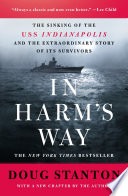In Harm’s Way: The Sinking of the USS Indianapolis and the Extraordinary Story of Its Survivors is a must read book for anyone remotely interested in World War II, particularly the Pacific theater, being stranded in the ocean or how bureaucracies love to scapegoat others for their mistakes. It is well written and a quick read. If Doug Stanton’s other books are as good, I think that he should give nonfiction writing lessons to the majority of award winning authors who are superb researchers, but can’t communicate what they discovered to an audience if their lives depended on it (I’m talking to you, Tim Weiner and John Hershey) and will make a book lover question their habits.
In Harm’s Way is right up there with Erik Larson’s The Devil in the White City: Murder, Magic, and Madness at the Fair that Changed America in terms of a nonfiction book having the same momentum and ability to capture its reader’s attention as a novel. Yes, the story is innately compelling, but I’ve seen it butchered before. The only reason that I read this book is because I watched USS Indianapolis: Men of Courage, which was a dreadful movie from soup to nuts, and figured that anything else had to do a better job telling the story. This story inspired Jaws, one of the greatest movies of all time.
In Harm’s Way tells the story of the USS Indianapolis’ last secret mission, to carry parts that would make one of the first atomic bombs, but after it was done delivering the parts that would make the weapon, no one noticed when it failed to arrive at its final destination. The USS Indianapolis was also the last ship that the Japanese forces blew out of the water. The majority of the men died in a few days either from succumbing to their injuries or the elements, lack of fresh water and food or shark attacks. After they were rescued, the USS Indianapolis’ captain would experience one last first: the first US Captain to be court-martialed for getting torpedoed, which the men who served him tried to get reversed and eventually succeeded posthumously. This book actually helped them succeed in the final mission to exonerate the captain. It is so well researched and invokes the human side of the story that it made bureaucrats act decently.
In Harm’s Way’s story would be daunting for another writer. Stanton has to help us understand arcane navy warfare policy and practice. He has to communicate the practical logistics of water warfare, which requires some technical savvy. He has to explain the history of the conflict up to that point, tease what the Allies are trying to achieve to end the war, and is not aided by the fact that the Pacific theater is not as commonly known as the European front. He has to make medical knowledge understandable to a layperson. While he is doing all of this, he has to get us invested in the individuals so we don’t just mentally checkout because of the overwhelming scope of this story. He also has to deal with a lot of moving pieces and jump around geographically to tell the story of people in different locations. He never drops the ball.
It takes 12 pages of small print to list the names of the crew and officers of the USS Indianapolis. In Harm’s Way is told in such a gripping way that if I began to confuse individuals, I could instantly go back to the passage in which Stanton introduced that person to refresh my memory. I never had to go to the table of contents. Stanton creates a lasting impression of each tree in the forest and makes us feel the importance of each life on board the USS Indianapolis. As someone who grabs a moment to read here and there and is constantly interrupted, I can easily forget details and lose the thread of a story, but I never had that problem with this book. Indeed it felt awful to put the book down and leave the men in peril so I felt a sense of urgency to prioritize reading it.
It is amazing that even with all the technology and expertise that we have, even expert navy men were ultimately unprepared for an expected emergency and would be rendered helpless and vulnerable in seconds. It is astounding that over a thousand men and a vessel prized by the President himself could be missing, but no one noticed except by accident. The combination of the nature and incompetence of men (not the ones on the USS Indianapolis) was more lethal than an enemy combatant!
If you enjoy reading and are just looking for a good book, I highly recommend In Harm’s Way. While it can be harrowing at times, it is so absorbing and will make you feel so grateful to not be them that it may be worth the trade off. I went in to the book expecting to learn more about the Pacific Theater, but I also got a glimpse of work life on board an impressive ship and the relationships of the men to each other. I’m very into stories of survival in the wild, and this book ranks high on the list with The Perfect Storm and Jon Krakauer’s books with more of an emphasis on the inner life of the individuals in that crisis.

In Harm’s Way
Stay In The Know
Join my mailing list to get updates about recent reviews, upcoming speaking engagements, and film news.




